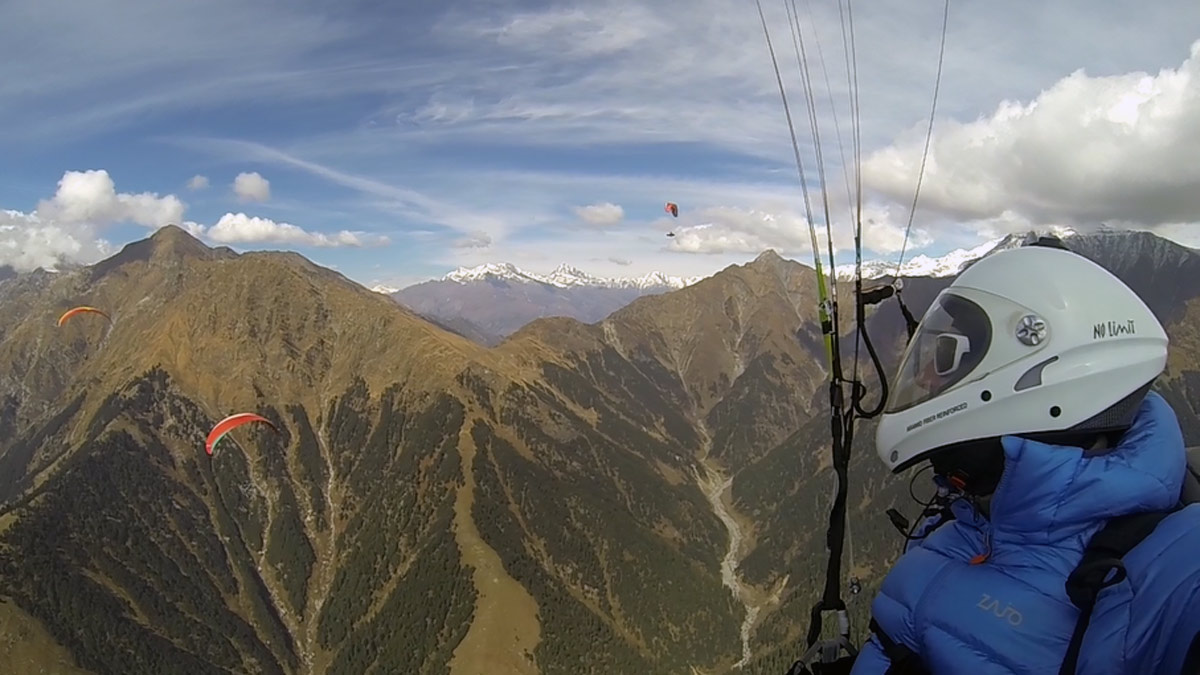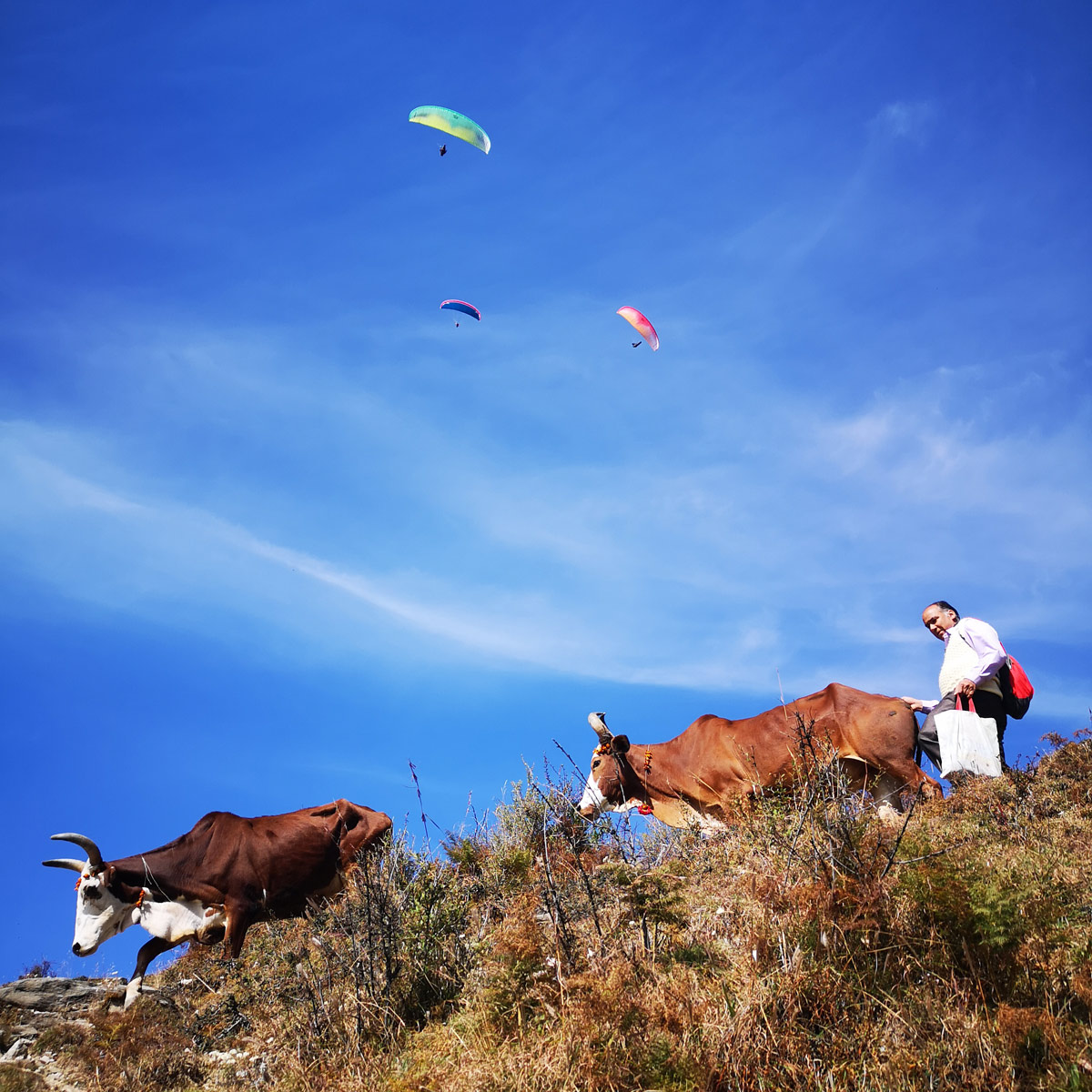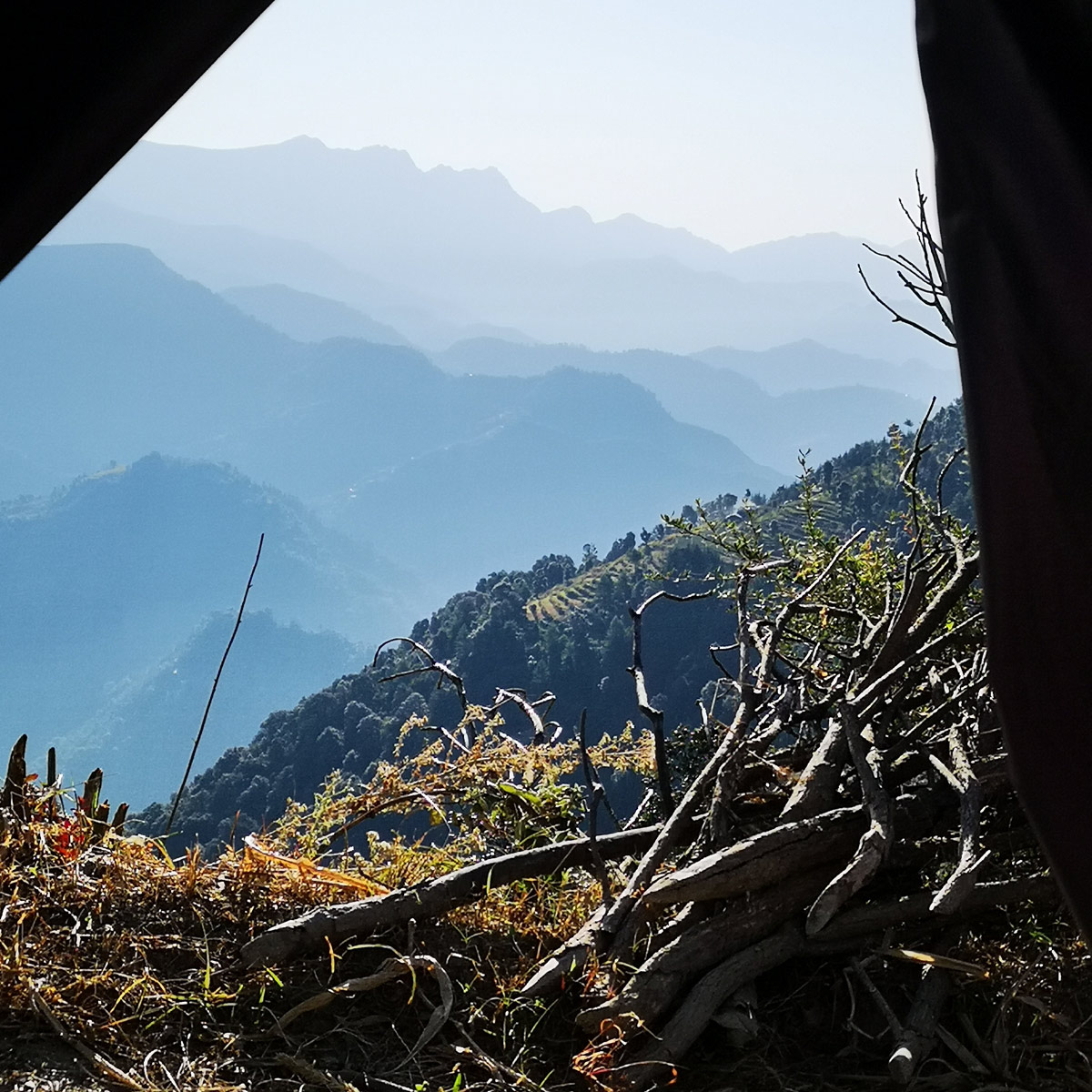
From the moment you arrive in Delhi or Amritsar the smells, sights, sounds and vibrations of India explode onto the senses. Far more than just another trip to a paragliding destination, a visit to the Himalayas takes you into a different world, one which will change you in unexpected ways. India is a vast sub-continent, an incredible fusion of culture, chaos and magic that cannot be described. It has to be experienced.

It’s not just the culture that is overwhelming. Even after 500-odd flying hours in eight countries, Bir (India’s most well-known paragliding site) turned out to be intimidating. The front, lower ridge does not look unfamiliar to anyone who’s flown European mountains, but when I arrived, the air was unseasonably spring like – which in Bir means overdeveloping and somewhat turbulent. In the 2018 autumn season it also meant a particularly high accident rate. One day before I arrived a Spanish pilot went missing over the back, then during the first three days flying of the first week I was there, more than 15 accidents occurred including 2 fatalities. You read that correctly, in half a week, of perhaps 800 or so pilots flying 2% of pilots who took to the air had accidents of varying severity.
No one can say why the accident rate was so high. One of Himalayan Sky Safari’s seasoned guides, Eddie Colfox, pointed out the hazards of tall clouds, stone terraces, uncommitted launches and letting go of controls whilst low as just some of the factors contributing to the various accidents, but no single factor explains why accidents were such an issue during the week I arrived.

The problem was so extreme that even in India, where concerns about safety are rather limited, the authorities closed flying for a day to convey a strong message to the pilots and instructors. Don’t fly alone, fly within your own abilities, observe local rules and use a Spot or InReach tracker (two-way satellite communication devices are restricted so be sure to explain at customs it is a tracker, not a satellite phone).
All that said, in terms of air behaviour and terrain Bir is certainly comparable in difficulty to Alpine or other mountainous sites. As with those places, you need to be current, competent and have practised wing control on an SIV course to be able to fly and land safely, it also pays to maintain a greater margin of safety than you might be used to. The terrain is unforgiving and the safety net of medical assistance should you need it is not nearly as readily available.
It certainly seems that normal risk assessment goes out of the window for pilots when flying abroad, my best guess is that this higher risk tolerance, coupled with strong dry thermals and pilots flying low over the mountainous terrain, combined in a dangerous combination.

All of which meant I was particularly grateful to have Eddie leading out on longer flights to show me the way. Seeing a wing in front, how much it moves around and whether it is reacting to the air in a way which suggests a collapse might be on the cards, is invaluable information when choosing a line and where to gain height. Knowing which spurs are likely to produce turbulence and which to produce lift, can prevent mistakes which might otherwise be made by the unwary or uninformed.
Another intimidating factor is the scale of the landscape. Heading over the back even one valley deep is entry into a world where landing out is both tricky and would entail at least a day’s walk out to get back. Even just flying in such country feels more fatiguing than the flatland flying I’m more used to. Keep heading North and you’ll swiftly find yourself in high mountain country, not a place for the inexperienced to unexpectedly find themselves on the ground. Yet those mountains, they beckon like sirens – come on in, if you think you’re hard enough! One day, I may have the skills to take them on with at least some margin for error…

My preferred flying technique for flying in Bir was to always keep as much height over terrain as possible to maximise reserve deployment time should it be needed. Where low, in situations such as gaining height on a spur after a transition, I’d be super vigilant and lock into a strong core as quickly as I could.
The inversions served up by stable humid plains air from the Punjab meeting the dryer air from the mountainous region also offered an exciting exercise in wing control, but a far less dangerous one as they were generally encountered with good ground clearance. A number of times we had to keep knocking on the door of an inverted layer before finding a core strong enough to break through, which made for a bouncy ride but also a very satisfying flight when accomplished.

My aim for my Himalayan trip was to enjoy a balance of land and air-based pursuit as I really wanted to experience being in the place as well as flying above it. Non-flying days were a welcome interlude to the high adrenalin experience of the flying and gave me a great opportunity to explore and sample the culture and reality of daily life in India.

Perhaps through having such a disparate culture with Hindu, Buddhist, Christian and Muslim faiths living alongside each other, Indian people in this area are by nature friendly and open and there is a high tolerance and a curiosity towards foreigners: given an opportunity, many willingly sharing their time just for the sake of enjoying a connection with a visitor.

Highlights of my non-flying time included: Landing in Dharamsala, staying the night in Mcleod Gang then sightseeing the next day, buying incredible Thangka artwork, later meditating 6 feet away from the Dalai Lama as he led afternoon prayers;

Blissing out in the Tatwani hot spring waterfall, after an almost equally enjoyable 2-hour expedition by 100 cc Honda and 50-minute hike to get there;

Taking a trip out to the neighbouring Barot Valley via Enfield Bullet, for a much colder swim in the river there;
Whilst on the optional 90-minute walk up to take off, finding myself being blessed by a local family at the Hindu temple dedicated to the spirit of Billing mountain, then sharing a brunch of freshly killed and cooked chicken.
Then there is Delhi – a whole other travel experience in itself!

Next time I visit Bir I’ll travel via Amritsar, which offers a more convenient journey as well as a different city to visit. Delhi is certainly interesting, but I won’t be rushing back anytime soon. I’ll also bring a better camera set-up and less warm clothes as the valley delivers great weather for getting a tan. I’d certainly recommend leaving a couple of days either side of a trip with Himalayan Sky Safaris, as my fellow pilot wasn’t able to enjoy his first few days’ flying due to still being jet lagged.

I really appreciated being able to have a relaxed attitude to the paragliding, knowing there was enough time to fly to my heart’s content whilst still being able to see some of this amazing country.
On a more personal note, due to the challenging conditions and the accidents happening all around me, I certainly underwent a period of reflection and questioning my choice to be a paraglider pilot.

Perhaps the period of reflection took me to a newfound (and Indian) place of fatalism, perhaps it was a renewed determination to be master of my own destiny and set with conviction my daily intention to fly safely and well, or perhaps it was just the impressive behaviour of my well loaded Artik 4 which never once gave more than a tip collapse. Whatever the cause, by the end of the trip I’d found a peace and tranquillity in the air I did not have when I arrived.
I also came away with a more balanced approach to flying paragliders. I enjoyed my time in the air, but perhaps more importantly equally enjoyed my time on the ground. After 10 years as a pilot, I have come to the understanding I wish to fly not from compulsion or the need to prove anything to myself or anyone, but to simply enjoy the whole experience, the airtime as well as the lifestyle and adventure, and perhaps most importantly without having to view the sky with regret on days when life takes me elsewhere.

In terms of kit, I flew my Medium Niviuk Artik 4 with Advance Lightness 2 harness at about 95 kg all up, a setup with which I am familiar and which proved to be a great companion for the trip. The wing staying solid pretty much the whole time, with only a single undramatic 30% collapse to speak of. I couldn’t have been more confident in the wing, Carlo won the 2015 XC league on this particular one so I guess he trained it well! Jokes aside though, on my 6th wing and 4th harness, I’ve finally found a balance of performance and user friendliness, agility and stability which feels ideal for me to enjoy my XC adventures. My advice is if your equipment doesn’t feel right or inspire confidence, change it and take the time to get the set-up which really works for you.
My highest flight took me over the back to 14,000 feet, to places I would not have visited without the encouragement and safety net of an experienced guide. Views from that altitude were, needless to say, spectacular, the vista of the high Himalayas opening out before my eyes will stay in my memory for good, inviting me to return and fly ever deeper into their hidden valleys.

The last flight I took was certainly not the most spectacular, but perhaps the most enjoyable of the trip. Flying alone, after my hike up and spontaneous Hindu blessing led to a comparatively late take off and ignoring the gaggle of comp pilots attacking a 40 km task in the Indian Open paragliding competition, I followed the spurs West towards Dharamsala, setting a turn point 25 km out. The air was particularly gentle, the sky so late in the day uncrowded, leaving just me and the vultures thermalling together as the sunlight slowly faded to red. Making the most of weak late afternoon lift, I timed a return leg perfectly, gliding into the large landing field, a few hundred feet to spare after 3 ½ hours of saying farewell in serene, grateful appreciation of the landscape and terrain I’d been privileged to enjoy in that amazing place.
- Dickon Walker
For more info on flying in Bir, read this helpful guide to Bir on the Nova team blog.
Brought to you by Flybubble
Like what we do? The best way to thank and support us is to buy gear from us and recommend us to others. Review our service on Trustpilot and our products on Flybubble Shop. You can also subscribe to Flybubble Patreon. Thank you!

